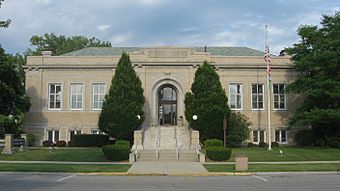Paulding County Carnegie Library facts for kids
Quick facts for kids |
|
|
Paulding County Carnegie Library
|
|

Front of the library
|
|
| Location | 205 S. Main St., Paulding, Ohio |
|---|---|
| Area | Less than 1 acre (0.40 ha) |
| Built | 1912 |
| Architect | Howard & Merriam |
| Architectural style | Beaux-Arts |
| NRHP reference No. | 83002021 |
| Added to NRHP | April 21, 1983 |
The Paulding County Carnegie Library is a special old building in Paulding, Ohio. It's a type of library called a Carnegie library, named after a famous person who helped build many libraries. This library was built a long time ago, in the early 1900s.
It has been the main library for all of Paulding County since it opened. Because it's so important and has a unique history, it's now known as a historic site.
Contents
How the Library Started
Back in the 1890s, Paulding didn't have a library at all. A group of local women, part of a "women's club," thought this wasn't good. So, in 1893, they collected money to start a small collection of books.
About ten years later, in 1903, different groups of people in Paulding met to create a real public library. They started with about 600 books! In its first few years, the library didn't have its own building. It moved around to different shops downtown and even to the librarian's house.
Andrew Carnegie's Gift
Around this time, many new public libraries were being built across the country. This was often thanks to a very rich man named Andrew Carnegie. He was a steel businessman who gave away a lot of his money to help communities. He especially liked to help build libraries.
Many big cities in Ohio, like Columbus and East Liverpool, got money from Carnegie for their libraries. But smaller towns like Paulding usually didn't.
However, the people of Paulding worked hard to ask Carnegie for money. And they succeeded! Carnegie agreed to give them money to build a library. What made this library extra special was that it was the first Carnegie library built to serve an entire county, not just one city.
The whole process of getting the money and building the library took about three years, from 1912 to 1914. Since it was finished, the library hasn't changed much. It's still a very important part of the community today. You can find it on South Main Street, close to the center of town.
What the Library Looks Like
In 1911, Andrew Carnegie's helper, James Bertram, wrote down ideas for how libraries should be built. He wanted libraries to be useful and not too fancy. He had started asking for building plans to be approved because some libraries were being built with too many decorations.
The Paulding County Carnegie Library is a great example of Bertram's ideas. It doesn't have lots of fancy decorations. Instead, its design makes sure there's plenty of space inside for books and people. The inside layout is planned to be very efficient. The library board chose a design from a company in Columbus called Howard and Merriam. This company had also designed the Rutherford B. Hayes Presidential Center.
Building Materials and Style
Howard and Merriam designed the library using mostly brick walls with stone parts. Even though the main floor is a bit raised, the building has one main story. It also has a full basement that is partly above the ground.
The bricks are gray and laid in a special way. There are also details made of gray limestone from Indiana. To get inside, you walk up a stone staircase with a stone railing. The main entrance is inside a stone archway. On each side of the entrance, there are small windows with stone tops, called Palladian windows.
Outside, you can see other cool details. There are flat columns, called pilasters, on the corners. There are also stone bands, called string courses, that go around the building. You might also spot some decorative carvings called cartouches and a fancy top edge called a cornice.
Inside, the library has six rooms. There are three large rooms for books, a small entrance area called a vestibule, a lobby, and an office. The inside has beautiful marble in the vestibule and oak wood panels in the reading rooms. There are also fireplaces and more flat columns, called Tuscan pilasters. The library's style is mostly Neoclassical architecture, which is a classic style, with some Beaux-Arts influences, which means it looks grand and formal.
A Historic Place
In 1983, the Paulding County Carnegie Library was added to the National Register of Historic Places. This means it's recognized as an important historic building. It earned this honor because of its special architecture and its role in local history.
Its most important historical role was being the first county-level Carnegie library. This success encouraged many other small communities to ask for money from the Carnegie Corporation to build their own libraries. It showed how ideas about self-improvement and learning for adults spread to smaller, rural areas in the early 1900s.
Today, the Paulding County Carnegie Library is one of four historic places in Paulding County listed on the National Register. The others are the Paulding County Courthouse, the old train station in Antwerp, and a round barn near Paulding.
The Paulding County Carnegie Library is the main building for the Paulding County library system. This system also has other branches in the towns of Antwerp, Oakwood, and Payne.



